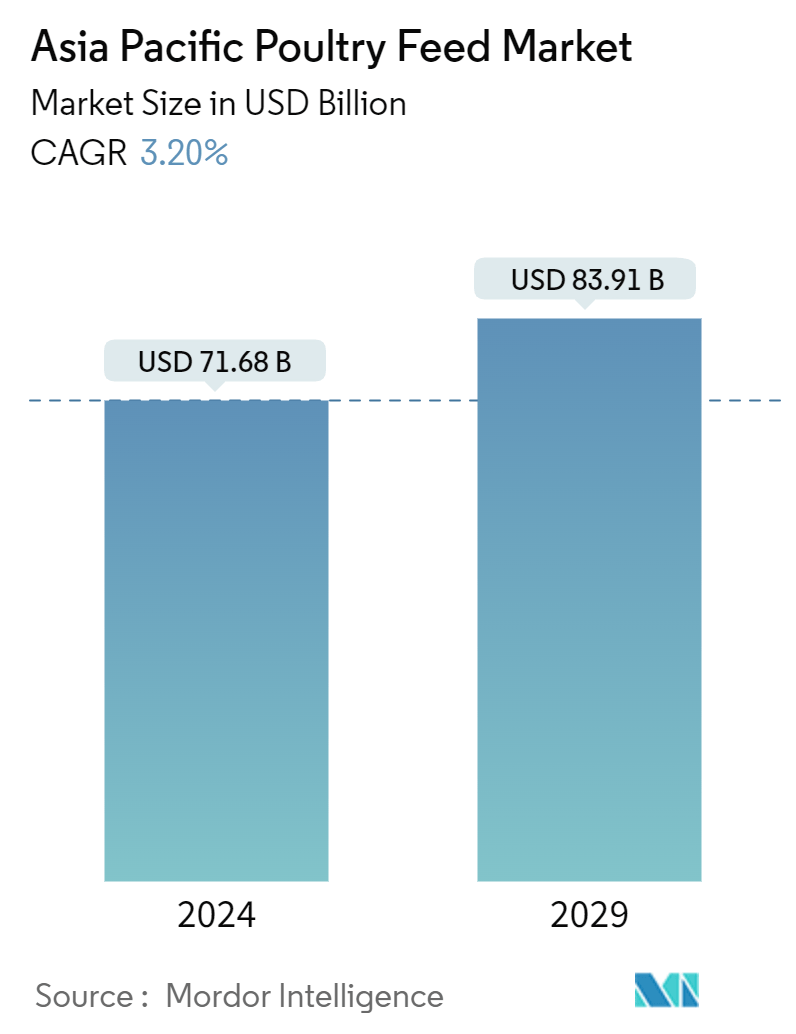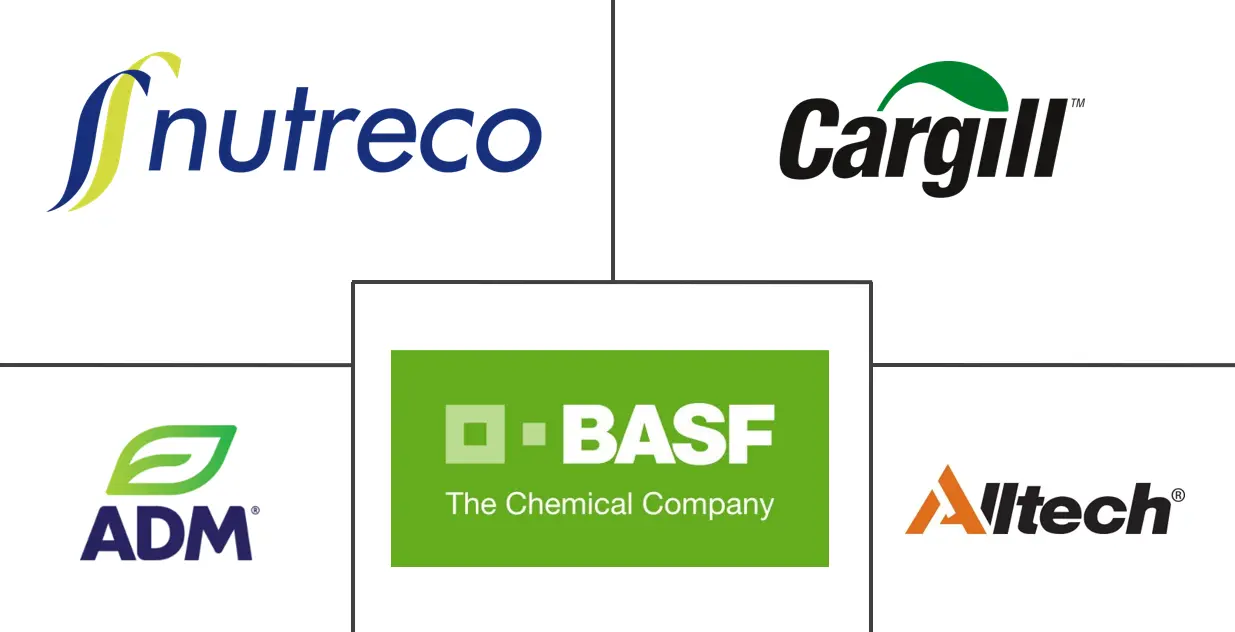Market Size of Asia Pacific Poultry Feed Industry

| Study Period | 2019 - 2029 |
| Base Year For Estimation | 2023 |
| Forecast Data Period | 2024 - 2029 |
| Market Size (2024) | USD 71.68 Billion |
| Market Size (2029) | USD 83.91 Billion |
| CAGR (2024 - 2029) | 3.20 % |
Major Players
*Disclaimer: Major Players sorted in no particular order |
Asia Pacific Poultry Feed Market Analysis
The Asia Pacific Poultry Feed Market size is estimated at USD 71.68 billion in 2024, and is expected to reach USD 83.91 billion by 2029, growing at a CAGR of 3.20% during the forecast period (2024-2029).
Asia-Pacific is the leading poultry feed-producing and consuming region in the world, thereby inflicting a direct impact on the feed market. The increased scale of industrial livestock production in the region has significantly contributed to increased feed production capacities in major economies across the region. As per FAO, the total production reached 1,118,543.7 thousand metric tons for poultry in 2022, as compared to 1,108,749.2 thousand metric tons in 2021 in Asia-Pacific.
The increasing demand for poultry meat products is the major factor driving the market. The rising industrial livestock production and demand for organic feed are two other factors augmenting the market's growth. Poultry is considered one of the most economical sources of protein, due to which poultry products such as eggs and meat are consistently witnessing growth in demand. Furthermore, the rising incomes of the consumers and increasing urbanization in Asia-Pacific are leading to increased demand for poultry products, which, in turn, is leading to the growth of the market studied.
Corn is a major component used for manufacturing other poultry feeds prepared for birds such as ducks, turkeys, and quail. In the upcoming years, the production of compound feed for other poultry birds is expected to flourish due to the policies being formulated for the upliftment of corn production in the Philippines and other Asia-Pacific regions. For instance, in August 2022, the governor of a province in the southeastern corner of the island of Mindanao, Philippines, initiated the consideration of proposals that aimed to expand corn production for use in poultry compound feed. Moreover, there has been an increase in investments in the region's poultry feed-production industry, which would boost the development of the poultry compound feed-production market in the countries. For example, in January 2024, San Miguel, one of the nation’s top commercial feed producers, initiated its plans of investing PHP 21 billion (USD 384 million) in the poultry feed and poultry industry in the country, along with opening 12 new poultry feed facilities.
Furthermore, the poultry industry is also benefiting from government incentives to support recovery and restocking. In 2020, several leading broiler enterprises invested in new broiler construction projects, with a total investment of up to RMB 7.4 billion (USD 1 billion). A combined effect of the drop in output and China’s stockpile of both corn and soy meal resulted in prices for feed grains to soar. China has increased imports of corn to compensate for the shortage, encouraging poultry feed manufacturers to switch to cheaper alternatives. Many of the domestic formulators have turned to wheat, which has a higher protein content than corn and soy.
Moreover, the increased costs of raw materials, along with increased demand for poultry feed materials, are anticipated to hamper the growth of the poultry feed market across Asia-Pacific during the forecast period. For instance, the average feed conversion ratio (FCR) of broiler feed in Thailand decreased to 1.6-1.7 in 2019 from 1.9-2.0 in the past five years. This distortion in the FCR indicates the country’s shift toward the inclusion of poor-quality feed ingredients. The domestic price of corn is one of the major factors influencing feed costs in the country. As mentioned by the Thai Feed Mill Association, feed costs account for nearly 60-65% of the broiler production and 20% of the swine feed in the country. This is mainly restraining the penetration of commercial feed in the country’s poultry industry.
Asia Pacific Poultry Feed Industry Segmentation
Poultry feed is a mixture of raw materials and supplements fed to the poultry birds, sourced from either plant, animal, organic or inorganic substances or industrial processing, whether containing additives. A balanced diet is essential according to the requirements for maintenance and various productive functions. Poultry feed is carefully formulated, ensuring optimal quantities of all essential ingredients. The Asia-Pacific poultry feed market is segmented by animal type (layer, broiler, turkey, and other animal types), ingredients (cereal, oilseed meal, oil, molasses, and other ingredients), supplements (vitamins, amino acids, antibiotics, enzymes, antioxidants, acidifiers, probiotics, and prebiotics, and other supplements), and geography (India, China, Japan, Australia, Pakistan, and Rest of Asia-Pacific). The report offers the market size and forecasts in terms of value (USD) and volume (metric tons) for the segments mentioned above.
| Animal Type | |
| Layer | |
| Broiler | |
| Turkey | |
| Other Animal Types |
| Ingredient | |
| Cereal | |
| Oilseed Meal | |
| Molasses | |
| Fish Oil and Fish Meal | |
| Supplements | |
| Other Ingredients |
| Supplements | |
| Vitamins | |
| Amino Acids | |
| Antibiotics | |
| Enzymes | |
| Antioxidants | |
| Acidifiers | |
| Prebiotics | |
| Probiotics | |
| Other Supplements |
| Geography | ||||||||
|
Asia Pacific Poultry Feed Market Size Summary
The Asia Pacific poultry feed market is experiencing steady growth, driven primarily by the increasing demand for poultry meat products. This demand is further bolstered by the rise in industrial livestock production and a growing preference for organic feed. The region's poultry industry is a significant contributor to the global feed additives market, with the Asia-Pacific region leading in both production and consumption of compound feed. The nutritional requirements of poultry, which include a substantial proportion of protein, fat, and calcium, are largely met through by-products and fish meal. Despite the challenges posed by high feed prices, the market continues to expand, supported by the need to enhance poultry productivity to meet the dietary needs of the growing regional population.
The poultry sector in Asia Pacific, particularly in countries like China and India, is one of the fastest-growing segments within the meat industry, with a notable shift towards broiler meat consumption. The region's poultry feed market is characterized by a fragmented landscape, with numerous regional players and a few large manufacturing companies. Leading firms are actively pursuing strategies to expand their market presence by acquiring feed mills and smaller manufacturing facilities both domestically and internationally. The market's growth is further supported by the adoption of intensive production systems, which have improved food conversion ratios and increased poultry output, particularly in China, where poultry production has outpaced other livestock sectors.
Asia Pacific Poultry Feed Market Size - Table of Contents
-
1. MARKET DYNAMICS
-
1.1 Market Overview
-
1.2 Market Drivers
-
1.2.1 Rising Demand for Poultry Products
-
1.2.2 Increasing Poultry Production
-
1.2.3 Growing Demand for Animal Protein
-
-
1.3 Market Restraints
-
1.3.1 Rising Cost of Feed Raw Materials
-
1.3.2 Challenging Regulatory Conditions
-
-
1.4 Porters Five Force Analysis
-
1.4.1 Threat of New Entrants
-
1.4.2 Bargaining Power of Buyers/Consumers
-
1.4.3 Bargaining Power of Suppliers
-
1.4.4 Threat of Substitute Products
-
1.4.5 Intensity of Competitive Rivalry
-
-
-
2. MARKET SEGMENTATION
-
2.1 Animal Type
-
2.1.1 Layer
-
2.1.2 Broiler
-
2.1.3 Turkey
-
2.1.4 Other Animal Types
-
-
2.2 Ingredient
-
2.2.1 Cereal
-
2.2.2 Oilseed Meal
-
2.2.3 Molasses
-
2.2.4 Fish Oil and Fish Meal
-
2.2.5 Supplements
-
2.2.6 Other Ingredients
-
-
2.3 Supplements
-
2.3.1 Vitamins
-
2.3.2 Amino Acids
-
2.3.3 Antibiotics
-
2.3.4 Enzymes
-
2.3.5 Antioxidants
-
2.3.6 Acidifiers
-
2.3.7 Prebiotics
-
2.3.8 Probiotics
-
2.3.9 Other Supplements
-
-
2.4 Geography
-
2.4.1 Asia-Pacific
-
2.4.1.1 India
-
2.4.1.2 China
-
2.4.1.3 Japan
-
2.4.1.4 Australia
-
2.4.1.5 Pakistan
-
2.4.1.6 Rest of Asia-Pacific
-
-
-
Asia Pacific Poultry Feed Market Size FAQs
How big is the Asia Pacific Poultry Feed Market?
The Asia Pacific Poultry Feed Market size is expected to reach USD 71.68 billion in 2024 and grow at a CAGR of 3.20% to reach USD 83.91 billion by 2029.
What is the current Asia Pacific Poultry Feed Market size?
In 2024, the Asia Pacific Poultry Feed Market size is expected to reach USD 71.68 billion.

